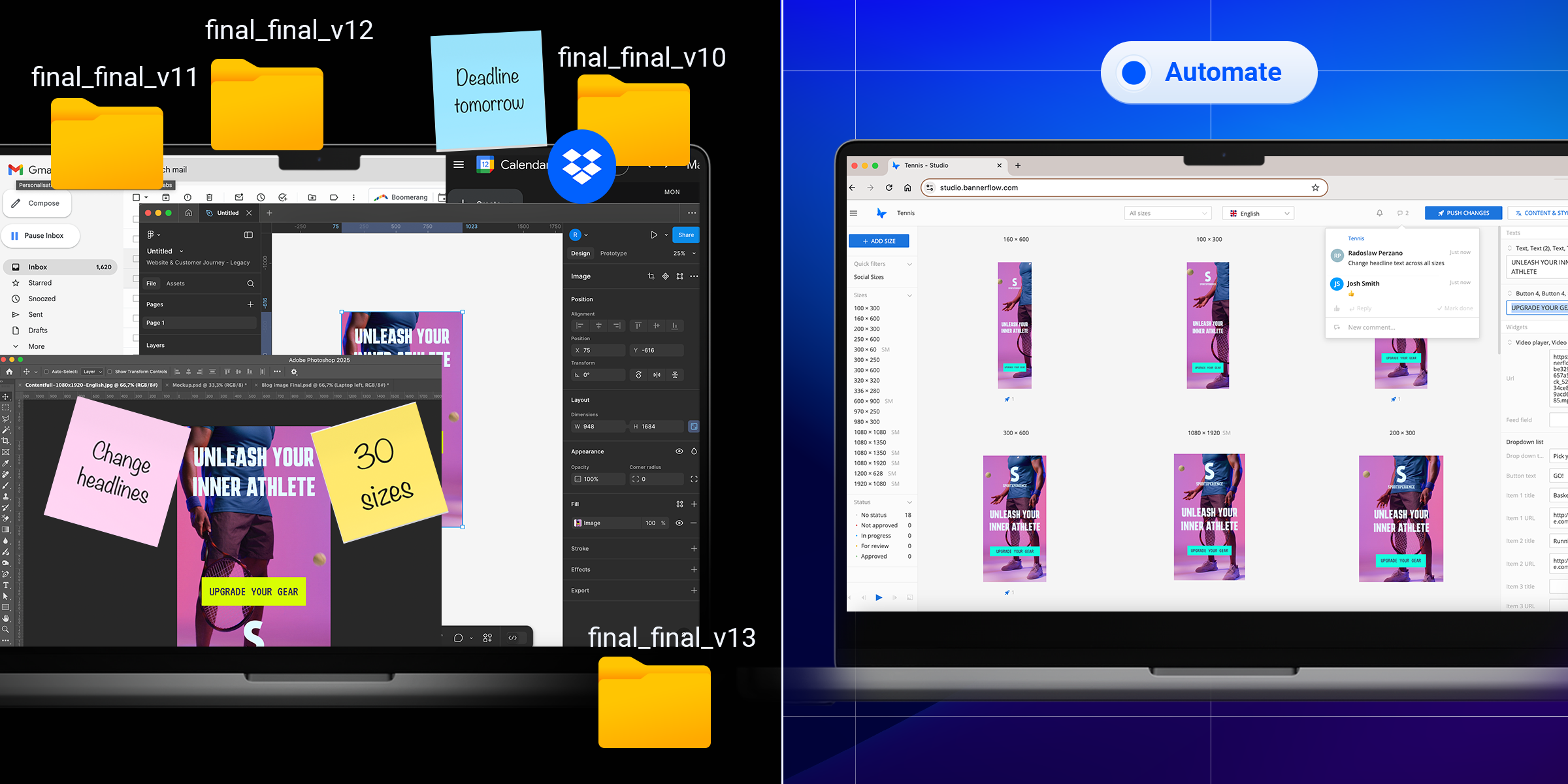Bannerflow Creative Studio: Complete Buyer's Guide
Enterprise-grade creative management platform
Bannerflow Creative Studio is an enterprise-grade creative management platform that combines AI-powered design automation with real-time campaign optimization across 100+ advertising networks[43][84]. The platform serves as a unified workflow solution integrating design creation, distribution, and performance analytics within a single interface, targeting organizations struggling with creative production bottlenecks and brand governance challenges across multiple markets.
Market Position & Maturity
Market Standing
Bannerflow operates in the enterprise tier of the AI banner generator market, serving over 2,000 brands and powering 225 billion ad impressions annually[84].
Company Maturity
Bannerflow demonstrates strong market maturity through 8+ years of continuous operation with established enterprise customers like Kindred Group maintaining platform usage since 2015[103].
Industry Recognition
Industry recognition emerges through customer retention patterns and enterprise adoption across regulated industries requiring brand governance and compliance capabilities[51][74].
Strategic Partnerships
Strategic partnerships encompass 100+ advertising network integrations providing comprehensive distribution capabilities without requiring custom API development[43][84].
Longevity Assessment
Long-term viability evidence includes continuous platform development, expanding network integrations, and sustained customer growth across enterprise segments.
Proof of Capabilities
Customer Evidence
Bannerflow serves notable enterprise customers including Club Med, Hallon, SEGA, Meliá Hotels International, Telia Company, Elkjøp, and Kindred Group[50][51][56][97][98][100][103].
Quantified Outcomes
Hallon achieved 20% conversion rate increases while doubling creative output[50][54], while Club Med eliminated 312 manual hours and reduced ad-serving expenses by 80% across 11 markets[51][55]. Telia Company documented 50% reduction in creative production time[56], and DeinDeal achieved 10x acceleration in product image processing handling thousands of daily updates[52].
Case Study Analysis
Club Med's systematic 11-market rollout demonstrates scalable deployment methodology with centralized regional libraries, standardized templates, and localized training approaches[51][55].
Market Validation
The platform processes 225 billion ad impressions annually across 2,000+ brands, indicating robust infrastructure and enterprise-grade reliability[84].
Competitive Wins
Customer implementations demonstrate successful replacement of manual workflows consuming 80% of marketing resources before automation[32].
Reference Customers
Enterprise customers include Club Med, Hallon, SEGA, Meliá Hotels International, Telia Company, Elkjøp, and Kindred Group[50][51][56][97][98][100][103].
AI Technology
Bannerflow's AI technology foundation centers on Dynamic Creative Optimization (DCO) engine that enables real-time personalization by combining live data feeds with behavioral targeting parameters[46][98].
Architecture
The platform's architecture supports API-driven automation enabling enterprise-scale deployment, as demonstrated by DeinDeal's 10x acceleration in product image processing handling 2,000-3,000 daily product updates[52].
Primary Competitors
Bannerflow competes directly with Adobe GenStudio in the enterprise segment[81].
Competitive Advantages
Real-time campaign adjustment capabilities allowing instant modification across advertising networks without asset re-uploading represent key differentiation[43][84].
Market Positioning
The platform's focus on operational efficiency over creative flexibility positions it for enterprises prioritizing workflow transformation and brand governance over design innovation.
Win/Loss Scenarios
Organizations should choose Bannerflow when requiring enterprise-scale brand governance, real-time campaign optimization across multiple networks, and documented operational efficiency improvements.
Key Features

Pros & Cons
Use Cases
Integrations
Featured In Articles
Comprehensive analysis of AI Banner Ad Creators for AI Design for AI Design professionals. Expert evaluation of features, pricing, and implementation.
How We Researched This Guide
About This Guide: This comprehensive analysis is based on extensive competitive intelligence and real-world implementation data from leading AI vendors. StayModern updates this guide quarterly to reflect market developments and vendor performance changes.
145+ verified sources per analysis including official documentation, customer reviews, analyst reports, and industry publications.
- • Vendor documentation & whitepapers
- • Customer testimonials & case studies
- • Third-party analyst assessments
- • Industry benchmarking reports
Standardized assessment framework across 8 key dimensions for objective comparison.
- • Technology capabilities & architecture
- • Market position & customer evidence
- • Implementation experience & support
- • Pricing value & competitive position
Research is refreshed every 90 days to capture market changes and new vendor capabilities.
- • New product releases & features
- • Market positioning changes
- • Customer feedback integration
- • Competitive landscape shifts
Every claim is source-linked with direct citations to original materials for verification.
- • Clickable citation links
- • Original source attribution
- • Date stamps for currency
- • Quality score validation
Analysis follows systematic research protocols with consistent evaluation frameworks.
- • Standardized assessment criteria
- • Multi-source verification process
- • Consistent evaluation methodology
- • Quality assurance protocols
Buyer-focused analysis with transparent methodology and factual accuracy commitment.
- • Objective comparative analysis
- • Transparent research methodology
- • Factual accuracy commitment
- • Continuous quality improvement
Quality Commitment: If you find any inaccuracies in our analysis on this page, please contact us at research@staymodern.ai. We're committed to maintaining the highest standards of research integrity and will investigate and correct any issues promptly.